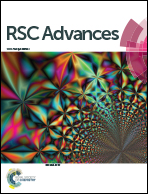Tunable multicolor luminescence and white light emission realized in Eu3+ mono-activated GdF3 nanofibers with paramagnetic performance
Abstract
Luminescent–magnetic bifunctional GdF3:Eu3+ nanofibers have been successfully fabricated via the combination of electrospinning followed by calcination with fluorination technique. The structure, morphologies, luminescence, and magnetic properties of the synthesized nanomaterials have been characterized by a variety of techniques. X-ray diffraction (XRD) analysis indicates that the as-obtained GdF3:Eu3+ nanofibers have a pure orthorhombic structure. Scanning electron microscope (SEM) observations show that the directly electrospinning-made PVP/[Gd(NO3)3 + Eu(NO3)3] composite nanofibers have smooth surfaces, uniform size and good dispersion, and the surfaces of GdF3:Eu3+ nanofibers become rough after calcination and fluorination process. The diameters of composite nanofibers and GdF3:Eu3+ nanofibers are respectively 333.26 ± 1.80 nm and 86.54 ± 0.55 nm under the confidence level of 95%. Under 274 nm ultraviolet light excitation, GdF3:Eu3+ nanofibers exhibit characteristic 5D3,2,1,0 → 7FJ emission of Eu3+ and the trend of their color tones changes from blue, cold white, warm white to red by adjusting the molar concentration of Eu3+. In addition, all of the samples exhibit paramagnetic features and the magnetic properties of GdF3:Eu3+ nanofibers are tunable by modulating the doping concentration of Eu3+ ions. More importantly, the tunable multicolor luminescence, white light emission and paramagnetic properties are simultaneously realized in single-phase GdF3:Eu3+ nanofibers, which are ideally suited to applications in many fields such as solid-state lasers, lighting and displays, magnetic resonance imaging. This design conception and construction strategy developed in this work may provide some new guidance for the synthesis of other rare earth fluoride nanostructures with various morphologies.


 Please wait while we load your content...
Please wait while we load your content...